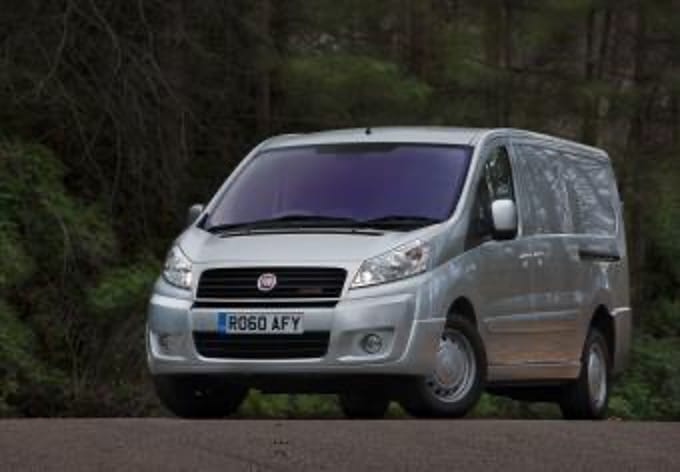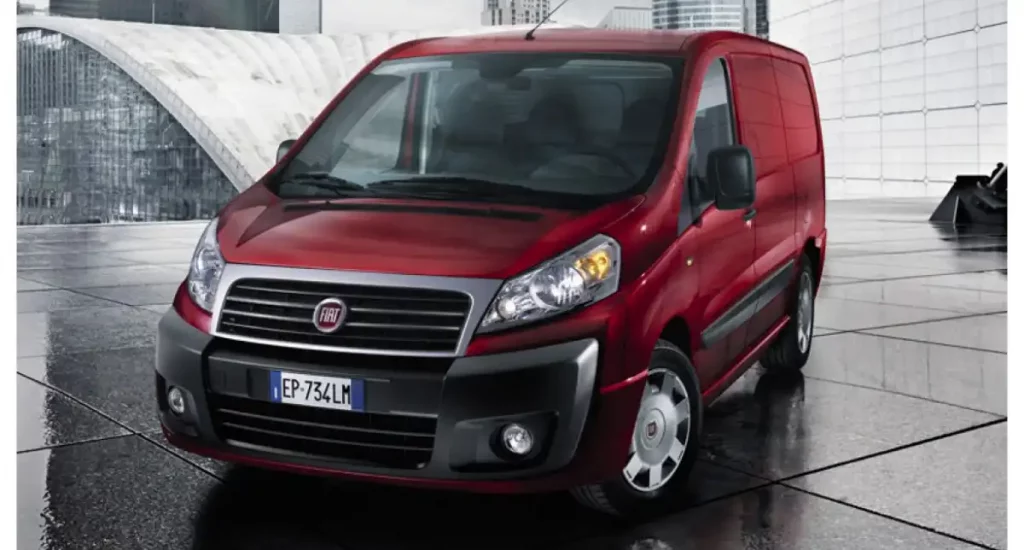Home »

The revamped Fiat Scudo as you see it now was first launched in early 2007 when LCV sales were on an upward trend. Built on a shared platform with its Sevel van siblings - Peugeot Expert and Citroen Dispatch – the new Scudo stormed to success securing the International Van of the Year award in 2008 in addition to starring in an advertising campaign with several Italian football stars and Formula One racing driver Michael Schumacher. Sales on the continent were encouraging, but in the UK the Scudo struggled to overturn the supremacy of the Volkswagen Transporter and Mercedes-Benz Vito.
Four years on, Scudo still trials in the wake of its German rivals, but the Fiat Professional range is catching up overall. Value for money, improving aftersales care and an impressive range of products have helped Fiat’s popularity, but will the addition of a new Euro-5 engine producing 163hp help entice new customers to the three tonne Scudo?
This test model, fitted with a revised 2.0-litre Multijet engine, is the first Scudo to meet Euro 5 regulations, achieving a claimed 40.9mpg on the combined cycle and CO2 emissions of just 181g/km. Impressive figures when you consider the 163hp and 3,400Nm of torque available.
In addition to the panel van, Euro-5 Scudo models are available as Panorama and Combi passenger vehicles, with all three models receiving air-conditioning and heated electric mirrors as standard.
Available only in Comfort trim – lower powered models have the option of a cheaper Business specification - the Euro-5 Scudo panel van is available with a choice of long or short wheelbases, but just one height option. Our test vehicle is the L2H1 model (long wheelbase) which starts from £19,385, while short wheelbase versions commence at £18,195.
The Euro-5 Scudo panel van comes with a choice of long or short-wheelbases (3,000mm or 3,122mm), and two height options (1,449mm or 1,750mm).

Competition at this end of the market is fierce so vehicles need to be practical, cost effective, and deliver a satisfying drive. Mercedes’ Vito 110, a Euro-5 rival to the Scudo, won high praise for its on-road manners and economy in a recent test (06/01/11) setting the benchmark high for the Scudo.
At city speeds the Scudo’s steering is nicely weighted and suitably direct, while on the motorway you can relax at higher speeds without the wheel becoming twitchy. Understandably as the speed increases so too does the noise, and although the Scudo was slightly louder at 76.7dB(A) compared to the Vito’s 73dB(A) you can still comfortably conduct a conversation.
Competition at this end of the market is fierce so vehicles need to be practical, cost-effective, and deliver a satisfying drive. Mercedes’ Vito 110, a Euro-5 rival to the Scudo, is well regarded for its on-road manners, and in a Van Advisor test set a high benchmark for the Scudo to beat in fuel economy.
At city speeds the Scudo’s steering is nicely-weighted and suitably direct, while on the motorway you can relax at higher speeds without the wheel becoming twitchy.
Unfortunately, getting up to that speed is more difficult than you would expect for a vehicle with 163hp. It’s not just the engine that struggled with a maximum 1,200kg payload on board either, as the Scudo’s suspension – which is surprisingly soft – sadly underperformed and failed to deliver a cushioned ride, instead diluting the Scudo’s sharpness on the open road; while long, awkward throws between the gates on the gearbox also did little to improve the overall experience. However, without a payload the Scudo is lightning quick and, although it corners very neutrally, it turns on the charm over an enticing B-road with its sharp wits and ample power.
As well as being less polluting, Euro-5 engines are also meant to be more economical, and with a claimed average consumption of just 40.9mpg the new Scudo promises a fuel saving over the 90hp, 120hp and 140hp models. Despite having nearly double the power and torque of the previously most efficient model, the 1.6-litre 90hp L1H1 model, the bigger and heavier Euro-5 Scudo manages a claimed 1.7mpg fuel saving.
Our laden and unladen tests didn’t quite hit the heady heights of 40+mpg, but the 37.6mpg recorded for the unladen run shows that the new more efficient Scudo is capable of supping fuel at an economical rate. However, in the laden runs the Scudo struggled to maintain the same performance scoring nearly 5mpg less on the usual routes, and while a fully loaded mpg of 32.8mpg isn’t bad, we’re not surprised by it either.
Unfortunately if fully loaded getting up to that speed is more difficult than you would expect for a vehicle with 163hp. It’s not just the engine that struggled with a maximum 1,200kg payload on board either, as the Scudo’s suspension – which is surprisingly soft - sadly underperformed and failed to deliver a cushioned ride, instead diluting the Scudo’s sharpness on the open road – while long, awkward throws between the gates on the gearbox also did little to improve the overall experience.
As well as being less polluting, Euro-5 engines are also meant to be more economical, and with a claimed average consumption of just 40.9mpg the new Scudo promises a fuel saving over the 90hp, 120hp and 140hp models. Despite having nearly double the power and torque of the previously most efficient model – the 1.6-litre 90hp L1H1 model – the bigger and heavier Euro-5 Scudo manages a claimed 1.7mpg fuel saving. Our laden and unladen tests didn’t quite hit the heady heights of 40+mpg but the 37.6mpg recorded for the unladen run shows that the new more efficient Scudo is capable of supping fuel at an economical rate. However in the laden runs the Scudo struggled to maintain the same performance scoring nearly 5mpg less on the usual routes, and while fully loaded mpg of 32.8mpg isn’t at all bad, we’re not surprised by it either as the Scudo struggled noticeable under the weight.
While weight was its downfall on the fuel run, adding our payload to the Scudo was relatively simple thanks to the twin sliding side doors. However, the absence of the usual access steps did make the loading height more difficult, but meant that our payload could be spread right the way across the width of the load area without danger of toppling into the recess and falling out when the side doors are opened. Full interior paneling also helped in keeping our load, and the skin of the van, protected and the optional full bulkhead (£90) provided extra security.
Climbing into the Fiat gives you a sense of being in a small car, as you sit quite low in the seat and see very little of the surrounding edges except for what is visible in the large mirrors. The functionality of the interior is practical with ample storage, and we like the grippy centre console cubby-hole, ideal for mobile phones, coins or keys, but on the whole the interior feels old and reminiscent of a car 20 years its senior.
| Model | Wheelbase | Length | Width | Height | Loadspace Length | Loadspace Width | Loadspace Height | Volume | Payload |
| L1H1 | 3,000 | 4,805 | 1,986 | 1,894 | 2,254 | 1,600 (1,245) | 1,449 | 5 | 1,000-1,200 |
| L2H1 | 3,122 | 5,135 | 1,986 | 1,894 | 2,584 | 1,600 (1,245) | 1,449 | 6 | 1,200 |
| L2H2 | 3,122 | 5,135 | 1,986 | 2,204 | 2,584 | 1,600 (1,245) | 2,204 | 7 | 1,200 |
The central dash area – encompassing a CD/radio with Bluetooth (£190) – appears mismatched to the rest of the vehicle, and the textured steering wheel, while comfortable to operate with its ergonomic design, feels dated. And if the unfashionable plastics don’t put you off, driving for a long distance probably will as the pedals, seat and steering column seem misaligned – a possible hangover from the LHD conversion – and the lack of room for your left leg adds further to the discomfort.
Climbing into the Fiat gives you an immediate sense of being in a small car, you sit quite low in the seat (although that can be adjusted to some extent) and see very little of the surrounding edges except for what is visible in the large mirrors.
The functionality of the interior is practical with ample storage and we particularly like the grippy centre console cubby hole, ideal for mobile phones, coins or keys, but on the whole the interior feels old and reminiscent of a car twenty years its senior. The central CD/Radio and heating controls appear mismatched to the rest of the vehicle, and the textured steering wheel – while comfortable to operate with its ergonomic design – feels dated. And if the unfashionable plastics don’t put you off, driving for a long distance probably will as the pedals, seat and steering column seem misaligned – a possible hangover from the LHD conversion- and the lack of room for your left leg adds further to the discomfort.
Fiat has gone to every length to allow you to get comfortable in the Scudo, with a height adjustable seat and a rake and reach adjustable steering wheel, but drivers over 6-foot will still feel cramped.
Small idiosyncrasies like rear doors that fold out ‘the wrong-way’ and a handbrake on ‘the wrong side’ take a while to get used to but add character, however, the cup-holder was only suitable for small tapered cups and when in use partially blocks the door handle and ignition.
Climbing into the Fiat gives you a sense of being in a small car, as you sit quite low in the seat and see very little of the surrounding edges except for what is visible in the large mirrors. The functionality of the interior is practical with ample storage, and we like the grippy centre console cubby-hole, ideal for mobile phones, coins or keys, but on the whole the interior feels old and reminiscent of a car 20 years its senior.
The central dash area – encompassing a CD/radio with Bluetooth (£190) – appears mismatched to the rest of the vehicle, and the textured steering wheel, while comfortable to operate with its ergonomic design, feels dated. And if the unfashionable plastics don’t put you off, driving for a long distance probably will as the pedals, seat and steering column seem misaligned – a possible hangover from the LHD conversion – and the lack of room for your left leg adds further to the discomfort.
Fiat Professional’s warranties have recently been extended to three years or 120,000 miles, while service intervals are set at 18,000 miles.
Since the divide with Fiat’s passenger car operations in 2007, the commercial or “Professional” products have only been sold through 153 authorised Fiat and Iveco truck dealerships. Prices start from £16,045 plus VAT.
The Scudo is typical no-thrills, run-of-the-mill van. There isn’t much to dislike about it; it’s cheap to run, practical and it handles relatively well although smaller engines may be a bit strained when carrying a full load.